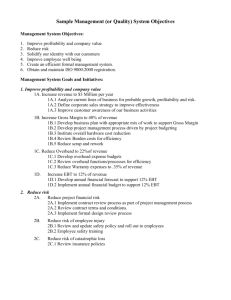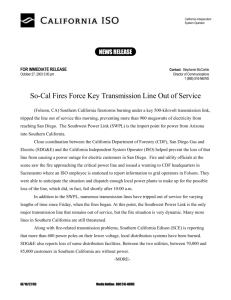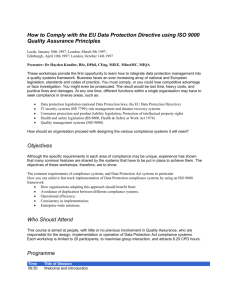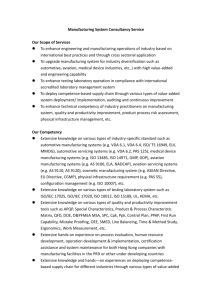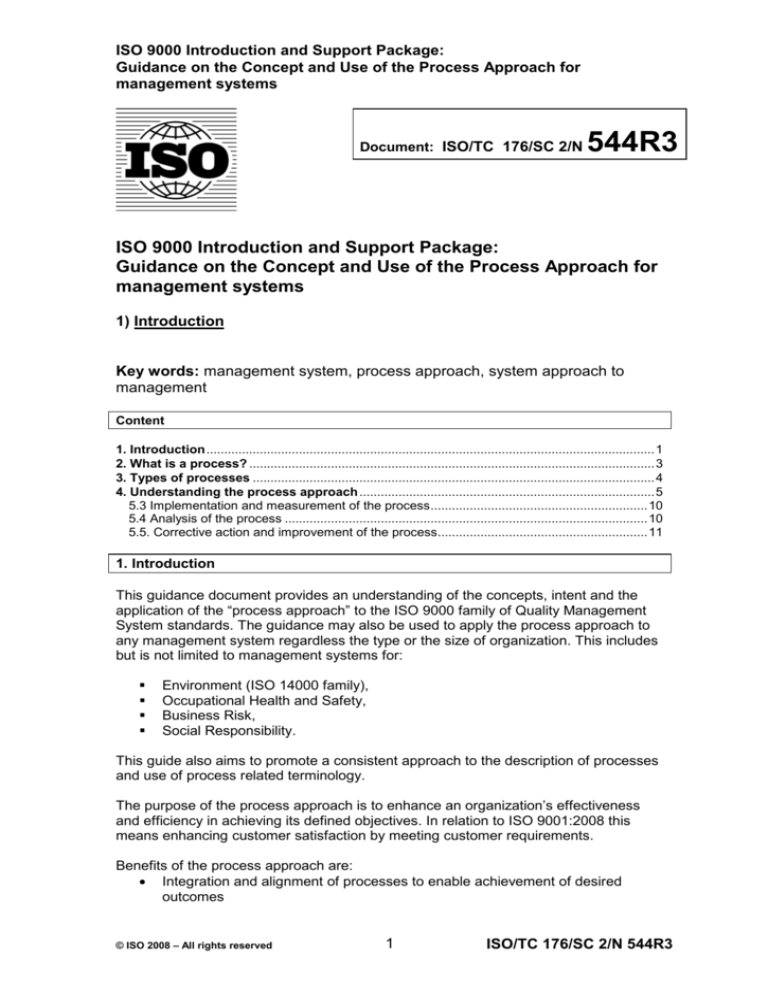
ISO 9000 Introduction and Support Package:
Guidance on the Concept and Use of the Process Approach for
management systems
Document: ISO/TC 176/SC 2/N
544R3
ISO 9000 Introduction and Support Package:
Guidance on the Concept and Use of the Process Approach for
management systems
1) Introduction
Key words: management system, process approach, system approach to
management
Content
1. Introduction .............................................................................................................................. 1
2. What is a process? .................................................................................................................. 3
3. Types of processes ................................................................................................................. 4
4. Understanding the process approach ................................................................................... 5
5.3 Implementation and measurement of the process ............................................................. 10
5.4 Analysis of the process ...................................................................................................... 10
5.5. Corrective action and improvement of the process ........................................................... 11
1. Introduction
This guidance document provides an understanding of the concepts, intent and the
application of the “process approach” to the ISO 9000 family of Quality Management
System standards. The guidance may also be used to apply the process approach to
any management system regardless the type or the size of organization. This includes
but is not limited to management systems for:
Environment (ISO 14000 family),
Occupational Health and Safety,
Business Risk,
Social Responsibility.
This guide also aims to promote a consistent approach to the description of processes
and use of process related terminology.
The purpose of the process approach is to enhance an organization’s effectiveness
and efficiency in achieving its defined objectives. In relation to ISO 9001:2008 this
means enhancing customer satisfaction by meeting customer requirements.
Benefits of the process approach are:
• Integration and alignment of processes to enable achievement of desired
outcomes
© ISO 2008 – All rights reserved
1
ISO/TC 176/SC 2/N 544R3
ISO 9000 Introduction and Support Package:
Guidance on the Concept and Use of the Process Approach for
management systems
•
•
•
•
•
•
•
Ability to focus effort on process effectiveness and efficiency.
Provision of confidence to customers, and other interested parties, about the
consistent performance of the organization.
Transparency of operations within the organization.
Lower costs and creation of shorter cycle times, through the effective use of
resources.
Improved, consistent and predictable results.
Provision of opportunities for focused and prioritized improvement initiatives.
Encouragement of the involvement of people and the clarification of their
responsibilities.
© ISO 2008 – All rights reserved
2
ISO/TC 176/SC 2/N 544R3
ISO 9000 Introduction and Support Package:
Guidance on the Concept and Use of the Process Approach for
management systems
2. What is a process?
A “Process” can be defined as a “set of interrelated or interacting activities, which
transforms inputs into outputs”. These activities require allocation of resources such
as people and materials. Figure 1 shows a generic process.
A major advantage of the process approach, when compared to other approaches, is
in the management and control of the interactions between these processes and the
interfaces between the functional hierarchies of the organization (as further explained
in section 4).
EFFECTIVENESS
OF PROCESS =
Ability to achieve
desired results
Input
Requirements Specified
(Includes resources)
Interrelated or interacting
activities and control
methods
Output
Requirements Satisfied
(Result of a process)
Monitoring and Measuring
EFFICIENCY OF
PROCESS =
Results achieved
vs. resources used
Figure 1. A generic process
Inputs and intended outputs may be tangible (such as equipment, materials or
components) or intangible (such as energy or information). Outputs can also be
unintended, such as waste or pollution.
Each process has customers and other interested parties (who may be either internal
or external to the organization), with needs and expectations about the process, who
define the required outputs of the process.
A system should be used to gather data to provide information about process
performance, which should then be analyzed to determine if there is any need for
corrective action or improvement.
All processes should be aligned with the objectives, scope and complexity of the
organization, and should be designed to add value to the organization.
Process effectiveness and efficiency can be assessed through internal or external
review processes.
© ISO 2008 – All rights reserved
3
ISO/TC 176/SC 2/N 544R3
ISO 9000 Introduction and Support Package:
Guidance on the Concept and Use of the Process Approach for
management systems
3. Types of processes
3.1 References to processes in ISO 9001:2008:
ISO 9001:2008 states:
In sub clause 0.1 General: “The design and implementation of an organization‘s quality
management system is influenced by: its business environment, changes in that
environment, or risks associated with that environment; its varying needs; its particular
objectives; the products it provides; the processes it employs; its size and
organizational structure. It is not the intent of this International Standard to imply
uniformity in the structure of quality management systems or uniformity of
documentation”.
In sub clause 0.2 Process Approach: “The application of a system of processes within
an organization, together with the identification and interactions of these processes,
and their management to produce the desired outcome, can be referred to as the
“process approach“.
In sub clause 4.1 General requirements: “The organization shall establish, document,
implement and maintain a quality management system and continually improve its
effectiveness in accordance with the requirements of this International Standard. The
organization shall:
a) determine the processes needed for the quality management system and their
application throughout the organization (see 1.2),
b) determine the sequence and interaction of these processes,
c) determine criteria and methods needed to ensure that both the operation and
control of these processes are effective,
d) ensure the availability of resources and information necessary to support the
operation and monitoring of these processes,
e) monitor, measure (where applicable), and analyse these processes, and
f) implement actions necessary to achieve planned results and continual improvement
of these processes.
These processes shall be managed by the organization in accordance with the
requirements of this International Standard”.
Based on the above, each organization should define the number and type of
processes needed to fulfil its business objectives. It is permissible for a process that is
required by ISO 9001:2008 to be part of a process (or processes) that is already
established by the organization, or to be defined by the organization in terms that are
different to those in ISO 9001.
3.2 Typical types of processes that can be identified:
In accordance with 3.1 above, organizations have to define the number and types of
processes needed to fulfil their business objectives. While these will be unique to each
organization, it is however possible to identify typical processes, such as:
-
Processes for the management of an organization. These include processes
relating to strategic planning, establishing policies, setting objectives, ensuring
© ISO 2008 – All rights reserved
4
ISO/TC 176/SC 2/N 544R3
ISO 9000 Introduction and Support Package:
Guidance on the Concept and Use of the Process Approach for
management systems
communication, ensuring availability of resources for the other organization’s
quality objectives and desired outcomes and for management reviews.
-
Processes for managing resources. These include all the processes that are
necessary to provide the resources needed for the organization’s quality
objectives and desired outcomes.
-
Realization processes. These include all processes that provide the desired
outcomes of the organization.
-
Measurement, analysis and improvement processes. These include the
processes needed to measure and gather data for performance analysis and
improvement of effectiveness and efficiency. They include measuring,
monitoring, auditing, performance analysis and improvement processes (e.g.
for corrective and preventive actions). Measurement processes are often
documented as an integral part of the management, resource and realization
processes; whereas analysis and improvement processes are treated
frequently as autonomous processes that interact with other processes, receive
inputs from measurement results, and send outputs for the improvement of
those processes.
4. Understanding the process approach
A process approach is a powerful way of organizing and managing activities to create
value for the customer and other interested parties.
Organizations are often structured into a hierarchy of functional units. Organizations
are usually managed vertically, with responsibility for the intended outputs being
divided among functional units.
The end customer or other interested party is not always visible to all involved.
Consequently, problems that occur at the interface boundaries are often given less
priority than the short-term goals of the units. This leads to little or no improvement to
the interested party, as actions are usually focused on the functions, rather than on the
intended output.
The process approach introduces horizontal management, crossing the barriers
between different functional units and unifying their focus to the main goals of
the organization.
It also improves the management of process interfaces (see Figure 2).
© ISO 2008 – All rights reserved
5
ISO/TC 176/SC 2/N 544R3
ISO 9000 Introduction and Support Package:
Guidance on the Concept and Use of the Process Approach for
management systems
Figure 2. Example of Process linkages across departments in an organization.
The performance of an organization can be improved through the use of the process
approach. The processes are managed as a system defined by the network of the
processes and their interactions, thus creating a better understanding of added value.
Note: The consistent operation of this network is often referred to as the "system
approach" to management.
Often the outputs from one process can be the inputs into other processes and are
interlinked into the overall network or system (for generic examples, see Figure 3 and
Figure 4).
Outputs from
other processes
Inputs
to A
PROCESS A
Inputs to B
Outputs
from A
Outputs from
other processes
PROCESS B
Outputs
from B Inputs to D
Outputs
from D
PROCESS D
Outputs
from C
Inputs to C
PROCESS C
Figure 3. Example of a generic process sequence
© ISO 2008 – All rights reserved
6
ISO/TC 176/SC 2/N 544R3
ISO 9000 Introduction and Support Package:
Guidance on the Concept and Use of the Process Approach for
management systems
Management
Management Processes
Processes
O
O
Process
Process Design
Design
II
O
O
II
II
Production
Production
Product
Product Design
Design
II
O
O
II
O
O
O
O
II
O
O
II
O
O
OO
Project
Project Planning
Planning
Measurement,
Measurement, Analysis,
Analysis, and
and Improvement
Improvement
II
Resource Processes
Processes
Resource
Figure 4. Example of a process sequence and its interactions.
© ISO 2008 – All rights reserved
7
ISO/TC 176/SC 2/N 544R3
ISO 9000 Introduction and Support Package:
Guidance on the Concept and Use of the Process Approach for management
systems
5. Implementing the process approach
The following implementation methodology can be applied to any type of process. The step
sequence is only one method and is not intended to be prescriptive. Some steps may be
carried out simultaneously.
5.1 Identification of the processes of the organization
Steps in the
process
approach
5.1.1
Define the
purpose of the
organization
What to do?
Guidance
The organization
should identify its
customers and other
interested parties as
well as their
requirements, needs
and expectations, to
define the
organization’s
intended outputs.
Gather, analyze and determine customer and other interested parties’
requirements, and other needs and expectations. Communicate frequently with
customers and other interested parties to ensure continual understanding of their
requirements, needs and expectations.
5.1.2
Define the
policies and
objectives of
the
organization
Based on the
analyses of the
requirements, needs
and expectations,
establish the
organization’s policies
and objectives.
Top management should decide which markets the organization should address
and develop relevant policies. Based on these policies, management should then
establish objectives for the desired outcome (e.g. products, environmental
performance, occupational health and safety performance).
5.1.3
Determine the
processes in
the
organization
Determine all the
processes needed to
produce the intended
outputs.
Determine the processes needed for achieving the intended outputs. These
processes include Management, Resources, Realization and Measurement,
Analysis and Improvement.
5.1.4
Determine the
sequence of
the processes
Determine how the
processes flow in
sequence and
interaction.
Determine the requirements for quality management, environmental
management, occupational health and safety, management, business risk, social
responsibilities and other management system disciplines that will be applied
within the organization.
Identify all process inputs and outputs, along with the suppliers, customers and
other interested parties (who may be internal or external).
Define and develop a description of the network of processes and their
interaction. Consider the following:
•
The customer of each process,
•
The inputs and outputs of each process,
•
Which processes are interacting,
•
Interfaces and their characteristics,
•
Timing and sequence of the interacting processes,
•
Effectiveness and efficiency of the sequence.
Note: As an example, realization processes (such as product delivered to a
customer) will interact with other processes (such as the management,
measurement and monitoring, and resource provision processes).
Methods and tools such as block diagrams, matrix and flowcharts can be used to
support the development of process sequences and their interactions.
© ISO 2008 – All rights reserved
8
ISO/TC 176/SC 2/N 544R3
ISO 9000 Introduction and Support Package:
Guidance on the Concept and Use of the Process Approach for management
systems
5.1.5
Define
process
ownership
5.1.6
Define
process
documentatio
n
Assign responsibility
and authority for each
process.
Management should define individual roles and responsibilities for ensuring the
implementation, maintenance and improvement of each process and its
interactions. Such an individual is usually referred to as the "process owner".
To manage process interactions, it may be useful to establish a "process
management team", that has an overview across all the processes, and which
includes representatives from each of the interacting processes.
Determine
those
processes that are to
be documented and
how they are to be
documented.
Processes exist within the organization and the initial approach should be limited
to determining and managing them in the most appropriate way. There is no
“catalogue”, or list of processes, that have to be documented.
The main purpose of documentation is to enable the consistent and stable
operation of the processes.
The organization should determine which processes are to be documented, on
the basis of:
•
The size of the organization and its type of activities,
•
The complexity of its processes and their interactions,
•
The criticality of the processes, and
•
The availability of competent personnel.
When it is necessary to document processes, a number of different methods can
be used such as graphical representations, written instructions, checklists, flow
charts, visual media, or electronic methods.
Note: For more guidance see the ISO 9000 Introduction and Support Package
module Guidance on the Documentation Requirements of ISO 9001:2008
5.2 Planning the process
Steps in the
process
approach
5.2.1
Define the
activities within
the process
What to do?
Determine the
activities needed to
achieve the intended
outputs of the
process.
Guidance
Define the required inputs and outputs of the process.
Determine the activities required to transform the inputs into the desired
outcomes.
Determine and define the sequence and interaction of the activities within the
process.
Determine how each activity will be performed.
Note: In some cases, the customer may specify requirements not only for the
outputs but also for the realization of the process.
5.2.2
Define the
monitoring and
measurement
requirements
Determine where and
how monitoring and
measuring should be
applied. This should
be both for control
and improvement of
the processes and
the intended process
outputs. Monitoring is
always applicable but
measurement may
not be practicable or
even possible.
Nevertheless
measurement gives
more objective data
© ISO 2008 – All rights reserved
Identify the monitoring and measuring criteria for process control and process
performance, to determine the effectiveness and efficiency of the process, taking
into account such factors as:
•
Conformity with requirements,
•
Customer satisfaction,
•
Supplier performance,
•
On time delivery,
•
Lead times,
•
Failure rates,
•
Waste,
9
ISO/TC 176/SC 2/N 544R3
ISO 9000 Introduction and Support Package:
Guidance on the Concept and Use of the Process Approach for management
systems
on the performance
of the process and it
is a powerful
management and
improvement tool.
•
Process costs,
•
Incident frequency.
Determine the need
for recording results.
5.2.3
Define the
resources
needed
Determine the
resources needed for
the effective
operation of each
process.
Examples of resources include:
5.2.4
Verify the
process against
its planned
objectives
Confirm that the
characteristics of the
processes are
consistent with the
purpose of the
organization (see
5.1.1)
Verify that all the requirements identified in 5.1.1 are satisfied. If not, consider
what additional process activities are required and return to 5.2.1 to improve the
process.
•
•
•
•
•
•
•
Human resources,
Infrastructure,
Work environment,
Information,
Natural resources,
Materials,
Financial resources
5.3 Implementation and measurement of the process
Implement the processes and their activities as planned.
The organization may develop a project for implementation that includes, but is not limited to
Communication,
Awareness,
Training,
Change management,
Management involvement,
Applicable review activities.
Apply the controls, and perform the monitoring and measurements as planned.
5.4 Analysis of the process
Analyze and evaluate process information obtained from monitoring and measuring data, in
order to quantify process performance. Where appropriate, use statistical methods.
Compare the results of process performance information with the defined requirements of the
process, to confirm process effectiveness and efficiency and to identify any need for
corrective action.
© ISO 2008 – All rights reserved
10
ISO/TC 176/SC 2/N 544R3
ISO 9000 Introduction and Support Package:
Guidance on the Concept and Use of the Process Approach for management
systems
Identify process improvement opportunities based on the results of the analysis of process
information.
Report to top management, and other relevant people in the organization, on the performance
of the process, as appropriate.
5.5. Corrective action and improvement of the process
Whenever corrective actions are needed, the method for implementing them should be
defined. This should include the identification and elimination of the root causes of the
problems (e.g. errors, defects, lack of adequate process controls). The effectiveness of the
actions taken should be reviewed. Implement the corrective actions and verify their
effectiveness according to plan.
When planned process outcomes are being achieved and requirements fulfilled, the
organization should focus its efforts on actions to improve process performance to higher
levels, on a continual basis.
The method for improvement should be defined and implemented (examples of improvements
include: process simplification, enhancement of efficiency, improvement of effectiveness,
reduction of process cycle time). Verify the effectiveness of the improvement.
Risk analysis tools may be employed to identify potential problems. The root cause(s) of
these potential problems should also be identified and eliminated, preventing occurrence in all
processes with similarly identified risks.
The Plan-Do-Check-Act (PDCA) methodology can be a useful tool to define, implement and
control corrective actions and improvements. Extensive literature exists about the PDCA cycle
in numerous languages.
Act
Plan
•How to improve
next time?
•What to do?
•How to do it?
Check
Do
• Did things happen
according to plan?
•Do what was
planned
“Plan”
Establish the objectives and processes
necessary to deliver results in
accordance with customer, statutory
and regulatory requirements and the
organization's policies;
“Do”
Implement the processes;
“Check”
Monitor and measure processes and
product against policies, objectives and
requirements for the product and report
the results;
“Act”
Take actions to continually improve
process performance;”
The PDCA is a dynamic methodology that can be deployed within each of the organization’s
processes and across their interactions. It is intimately associated with planning,
implementation, verification and improvement.
© ISO 2008 – All rights reserved
11
ISO/TC 176/SC 2/N 544R3
ISO 9000 Introduction and Support Package:
Guidance on the Concept and Use of the Process Approach for management
systems
Maintaining and improving process performance can be achieved by applying the PDCA
concept at all levels within an organization. This applies equally to all processes, from highlevel strategic processes to simple operational activities.
© ISO 2008 – All rights reserved
12
ISO/TC 176/SC 2/N 544R3


